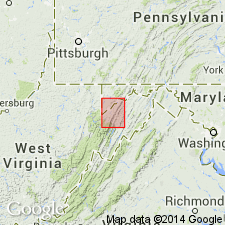
- Usage in publication:
-
- Juniata formation*
- Modifications:
-
- Original reference
- Dominant lithology:
-
- Sandstone
- Shale
- AAPG geologic province:
-
- Appalachian basin
Summary:
(Credited to N.H. Darton, Piedmont folio, WV-MD, no. 28, and Franklin folio, WV-VA, no. 32.) Juniata formation. Brownish-red sandstones alternating with red shales. Thickness 685 to 1,125 feet. Underlies Tuscarora quartzite and overlies Martinsburg shale. Is basal part of Medina of early reports on this region. Assigned to Silurian.
[Origin of name not stated.]
Source: US geologic names lexicon (USGS Bull. 896, p. 1060).
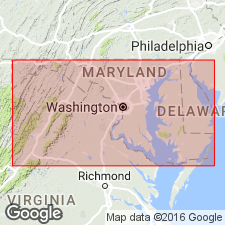
- Usage in publication:
-
- Juniata formation
- Modifications:
-
- Principal reference
- AAPG geologic province:
-
- Appalachian basin
Summary:
Pg. 172-188. Juniata formation (red Medina sandstone) of western Maryland is best developed in Willis Mountain, northwest of Cumberland, where it is 500 feet thick. Consists of alternating shales and sandstones of deep red color. Assigned to Silurian.
Named from typical occurrence of Juniata River in PA.
[GNC remark (ca. 1910, US geologic names lexicon, USGS Bull. 896, p. 1060): This formation continued to be universally assigned to Silurian (as was Medina group of New York) until 1908, when R.S. Bassler (Econ. Geol., v. 3, p. 510) classified the formation in Virginia as Ordovician and of Lorraine age. In 1909 (Sci., n.s., v. 29, p. 353, 355, 415) A.W. Grabau correlated Juniata with Queenston shale of western New York ("of late Lorraine and Richmond age"), and assigned both of these formations to Upper Ordovician. The Tuscarora, however, he placed in Silurian. Although no fossils were obtained from the rocks, the Juniata formaiton of USGS Mercersburg-Chambersburg folio, no. 170, 1909, was classified as Upper Ordovician.]
Source: US geologic names lexicon (USGS Bull. 896, p. 1060).
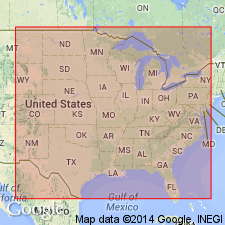
- Usage in publication:
-
- Juniata sandstone
- Modifications:
-
- Age modified
- AAPG geologic province:
-
- Appalachian basin
Summary:
Pl. 27. Assigned the Juniata to Upper Ordovician and the Richmond to Silurian; and, although no fossils were obtained, this classification of the Juniata was followed by G.W. Stose in USGS Pawpaw-Hancock folio, no. 179, 1912.
Source: US geologic names lexicon (USGS Bull. 896, p. 1060).

- Usage in publication:
-
- Juniata formation
- Modifications:
-
- Overview
- AAPG geologic province:
-
- Appalachian basin
Summary:
In 1913 (12th Intl. Geol. Cong., p. 593-666) E.O. Ulrich assigned Juniata formation (=Queenston shale) to Richmond epoch and assigned the Richmond to Silurian. Grabau, however, the same year (GSA Bull., v. 24, p. 408-410) assigned Juniata (=Queenston and =Richmond) to Upper Ordovician. Ulrich still classifies the Richmond group (and equivalent formations in other parts of the country) as Silurian. In this he is followed by R.S. Bassler, R. Ruedemann, and the present New York State and Pennsylvania State Surveys. The USGS and geologists and paleontologists in general assign the Richmond group and its equivalents to Upper Ordovician. Although the Juniata is nonfossiliferous, its correlation with Richmond group appears now to be accepted by all writers.
Source: US geologic names lexicon (USGS Bull. 896, p. 1060).
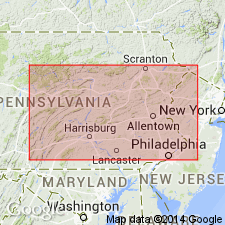
- Usage in publication:
-
- Juniata formation
- Modifications:
-
- Revised
- AAPG geologic province:
-
- Appalachian basin
Summary:
Term Oswego has been misapplied in PA. For beds commonly referred to by that name, Bald Eagle is revived and treated as basal Juniata. Overlies Martinsburg formation; underlies Tuscarora formation. There is a disconformity between Bald Eagle and Tuscarora east of Susquehanna River and either a disconformity or unconformity below Bald Eagle or Tuscarora or Shawangunk from Susquehanna River to southeastern NY. Either hiatus might be used as Ordovician-Silurian line of separation. If lower is accepted, Juniata is Silurian; if upper is used, then Juniata is Ordovician. [This is the only recorded usage of Bald Eagle as a member of the Juniata. All subsequent usage has been at formation rank.]
Source: GNU records (USGS DDS-6; Reston GNULEX).
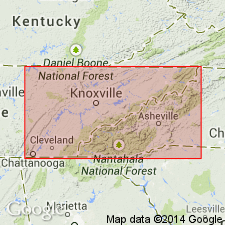
- Usage in publication:
-
- Juniata formation
- Modifications:
-
- Areal extent
- AAPG geologic province:
-
- Appalachian basin
Summary:
Geographically extended the Juniata formation to eastern TN. Juniata and Sequatchie formations form sheet of red or maroon sediments similar in lithology to older sheet represented by Bays and Moccasin formations.
Source: GNU records (USGS DDS-6; Reston GNULEX).
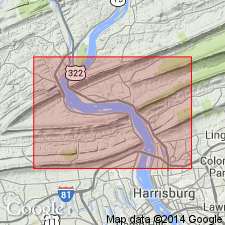
- Usage in publication:
-
- Juniata formation
- Modifications:
-
- Revised
- AAPG geologic province:
-
- Appalachian basin
Summary:
Subdivided the Juniata formation in PA into (ascending) East Waterford red sandstone member, Plummer Hollow red mudstone and sandstone member, and Run Gap red sandstone member. Unit overlies the Bald Eagle sandstone in western area and Lost Run conglomerate in eastern area.
Source: GNU records (USGS DDS-6; Reston GNULEX).
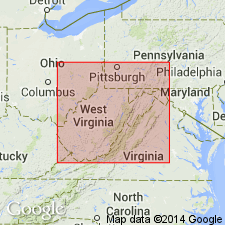
- Usage in publication:
-
- Juniata Formation
- Modifications:
-
- Revised
- AAPG geologic province:
-
- Appalachian basin
Summary:
The Juniata Formation is included as the middle formation in the Judy Gap Group in WV. Overlies the Oswego Formation and underlies the Tuscarora Formation, both of the Judy Gap Group.
Source: GNU records (USGS DDS-6; Reston GNULEX).
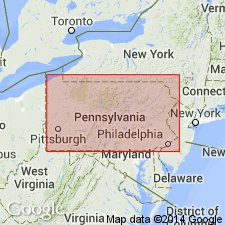
- Usage in publication:
-
- Juniata Formation
- Modifications:
-
- Areal extent
- AAPG geologic province:
-
- Appalachian basin
Summary:
The Juniata Formation in PA consists of grayish red siltstone, shale, and very fine- to medium-grained, cross-bedded sandstone. Unit overlies the Bald Eagle Formation and underlies the Tuscarora Formation. The Juniata is not present east of the Susquehanna River, except at Spitzenberg Hill, Berks Co.
Source: GNU records (USGS DDS-6; Reston GNULEX).
For more information, please contact Nancy Stamm, Geologic Names Committee Secretary.
Asterisk (*) indicates published by U.S. Geological Survey authors.
"No current usage" (†) implies that a name has been abandoned or has fallen into disuse. Former usage and, if known, replacement name given in parentheses ( ).
Slash (/) indicates name conflicts with nomenclatural guidelines (CSN, 1933; ACSN, 1961, 1970; NACSN, 1983, 2005, 2021). May be explained within brackets ([ ]).

